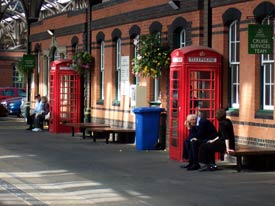|
By Durant Imboden

ABOVE: The former Marine Railway Station at
Dover's Western Docks is now a part of the Dover Cruise Terminal.
Port of Dover
Dover has been England's most convenient sea gateway to the
European continent since Roman times, and the Dover Harbour Board received its
charter from King James I in 1606. Today, ferries run between Dover and France
almost constantly, and the port's ferry terminals handle more than 1.8 million
trucks or lorries per year.
Dover has become increasingly popular as a cruise port, serving
more than 150,000 cruise passengers a year. The port, which is just under two hours
from London by train or car, has two adjacent cruise terminals at the Western Docks on
the edge of town:
Terminal 1 occupies the old Marine Railway Station (see
photo above), where ferry passengers once transferred from trains to Channel
steamers.
Terminal 2 is a new building farther down the pier.
Both terminals have attractive waiting rooms, snack bars,
toilets, and other facilities for cruise passengers. They're within reasonable
walking distance of the town center, although passengers arriving or departing
via the Dover Priory railroad station (which is above the town) will need to
hire taxis. For train times, use the Britain's
National Rail Enquiries journey planner.
For more
information on Dover's shipping and cruise facilities, see:
Port of Dover
Next page:
Dover shore excursions
|